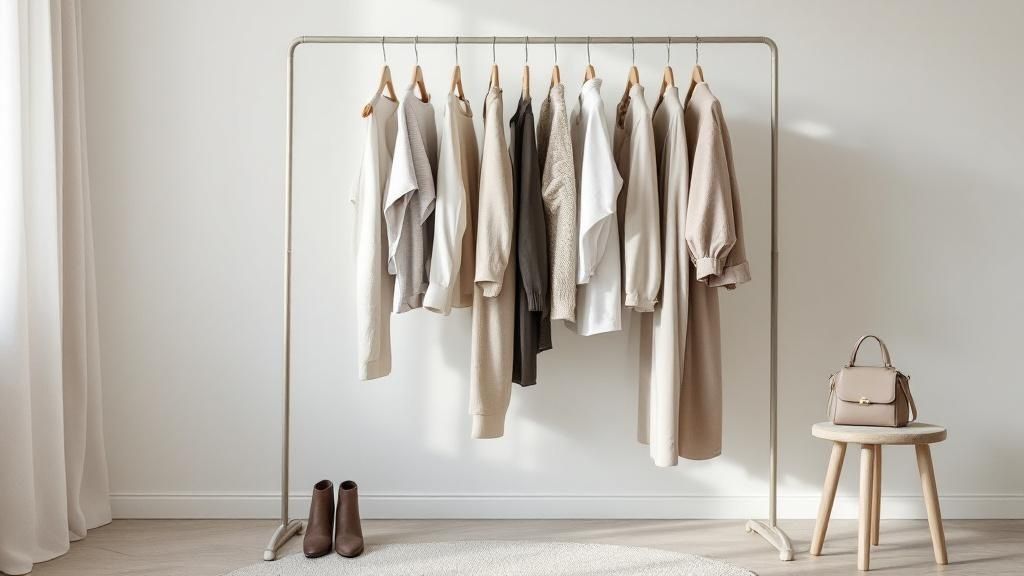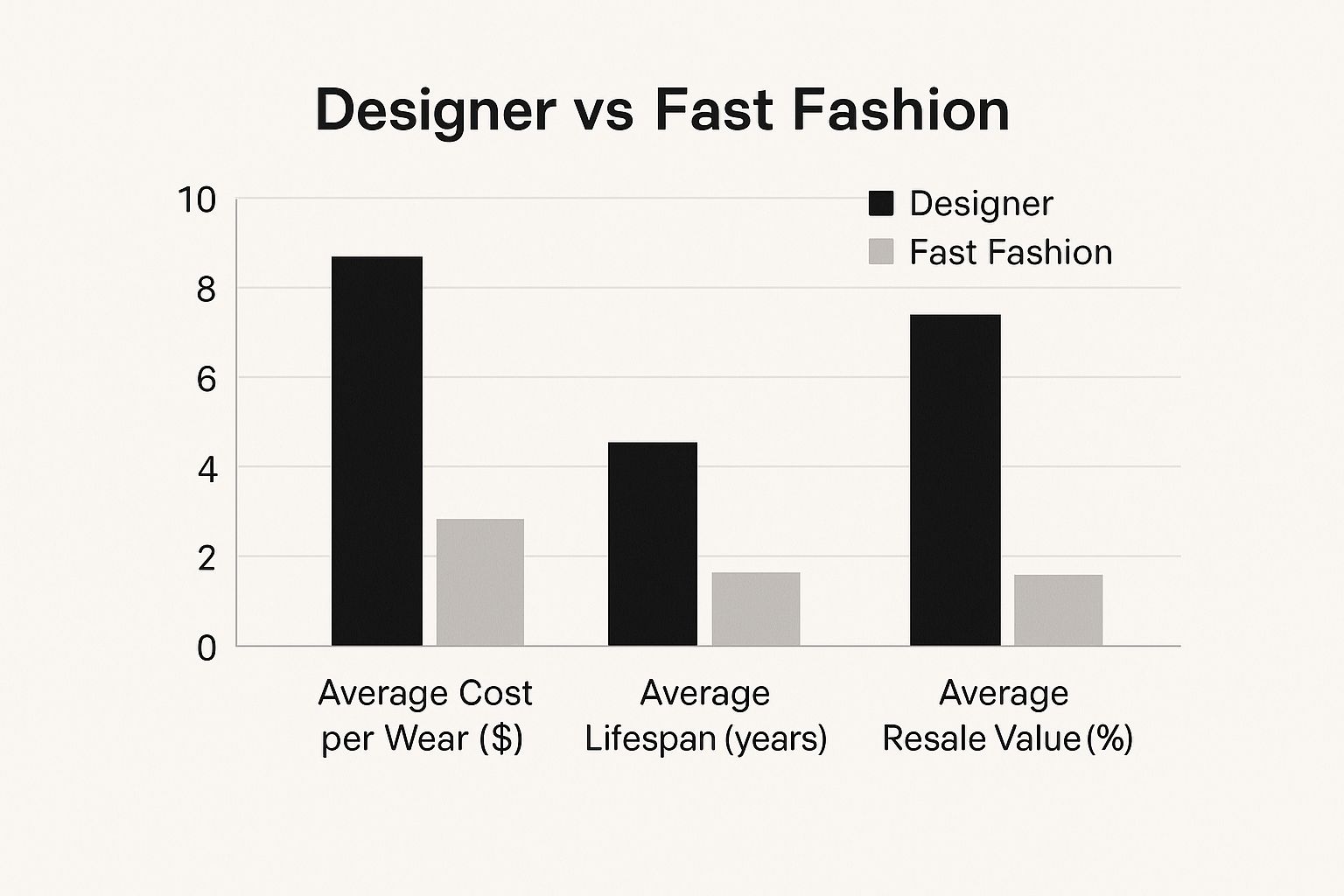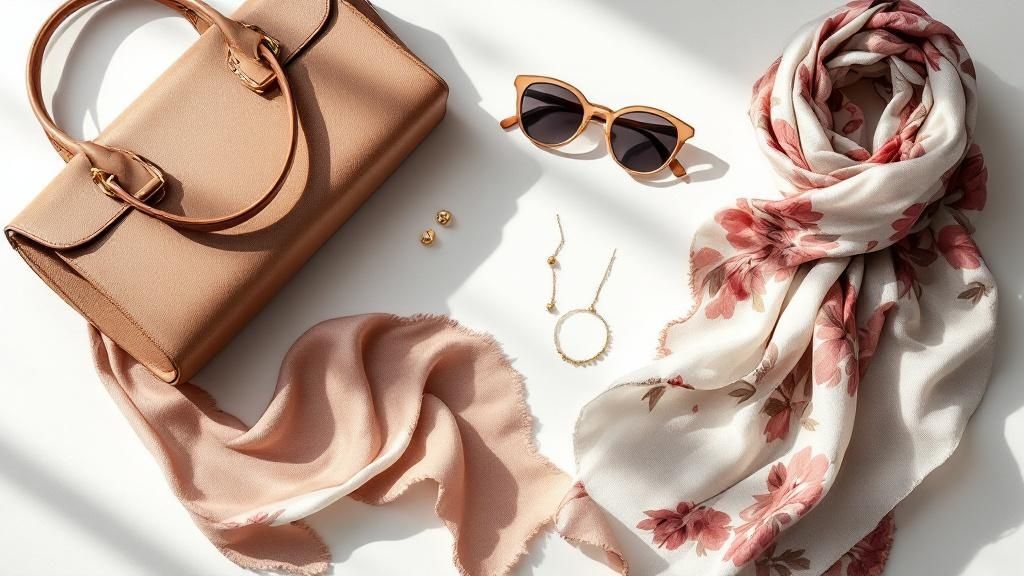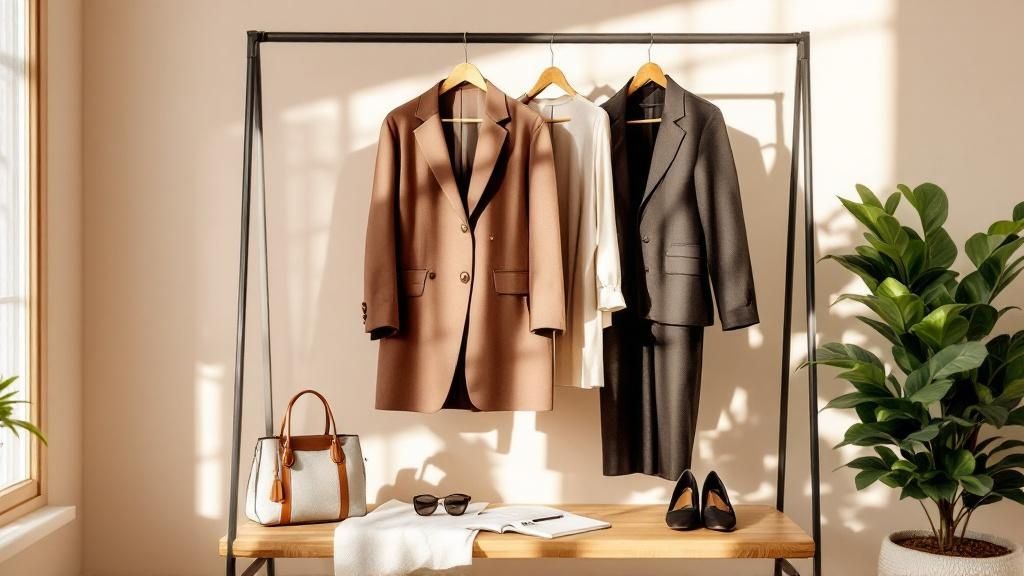Understanding What Makes Designer Fashion Worth It
Ever find yourself staring at a designer piece, looking at the price tag, and just wondering, "Is this really worth it?" It’s a fair question. Are you paying for a legacy of impeccable craftsmanship, or are you just buying into a very clever marketing campaign? The truth is usually somewhere in between.
Learning to spot the difference is the first real step toward building a collection of clothes you’ll love for years, not just a season. It’s about looking past the prestige and identifying real, tangible value.
Beyond the Brand Name: The Real Markers of Value
Genuine luxury isn't about a logo plastered across a plain t-shirt; it’s a quality you can see and feel. It’s in the details. Think about the satisfying heft of a well-made wool coat, the perfect, even stitching on a leather handbag, or the brilliant cut of a dress that hangs just so. These are the signs of true craftsmanship.
For instance, a brand might be famous for its trench coats not just because of its name, but because the gabardine fabric it pioneered is exceptionally durable and water-resistant. That’s innovation, not just branding. When you’re looking at an item, ask yourself if its price is based on a fleeting trend or on its actual quality and design integrity.
The Changing Face of Luxury
The days when luxury was locked away in intimidating, exclusive boutiques are mostly over. The environment today is far more accessible. We're seeing more direct-to-consumer brands offering incredible quality without the traditional retail markup, and the boom in the resale market has made pre-owned designer pieces more available than ever.
This isn’t a niche trend. The global apparel market is projected to be worth $1.84 trillion in 2025, with steady growth expected to push it toward $2 trillion. This massive scale creates more competition and, ultimately, more choices for shoppers who know what to look for. You can explore the complete market analysis here.
Distinguishing Timeless from Trendy
So, how do you spot a future classic versus something that will feel dated by next season? It’s less about guessing and more about having a clear checklist. Focus on these key areas:
- Silhouette over Season: Prioritize classic shapes that aren’t tied to a specific decade—think of a tailored blazer, a straight-leg trouser, or a simple silk blouse. These shapes have already proven their staying power.
- Material Longevity: Put your money into natural fibers like wool, cashmere, silk, and high-quality leather. They not only last longer but often look even better as they age.
- Functionality in Your Life: Be honest with yourself. Does this piece actually work for your career, your local climate, and the things you do? A beautiful but impractical item has zero real-world value.
- Brand Heritage vs. Hype: Look at brands known for perfecting a specific item (like Burberry for trench coats or Max Mara for camel coats) rather than those just pushing the momentary “it” bag of the season.
Understanding what gives a designer piece its value is your foundation. Now, let’s build on that by figuring out a realistic financial plan.
Creating Your Designer Wardrobe Budget Without Breaking the Bank

Let's be honest: the idea of budgeting for luxury fashion can feel like a contradiction. But building a designer wardrobe that you'll love for years isn’t about having an unlimited AmEx—it's about having a smart financial game plan. This is about intentional spending that fits your real-life financial picture, whether you're working with a $50K or $150K salary.
Shifting Your Money Mindset
The first move is to stop thinking about designer purchases as random splurges and start treating them like a dedicated "style fund." Think of it as a personal savings goal, much like putting money aside for a vacation. A good rule of thumb is to allocate 5-10% of your net income toward your wardrobe. For designer pieces, this means playing the long game; you might save this amount for several months to afford a single, incredible item that completely elevates your look.
This mindset is key because spending habits can be deceptive. While the average American buys around 53 fashion items annually at a low cost, the luxury equation is flipped. One beautifully crafted handbag can easily cost more than a year's worth of fast fashion, which makes a deliberate budget non-negotiable. You can get a deeper look into these fashion industry statistics here.
This brings us to what I call the "investment piece" fallacy. We often justify a big purchase by calling it an "investment," but a true investment piece should deliver returns through excellent cost-per-wear or solid resale value. That trendy "it" bag you bought on impulse but are too nervous to actually carry? That’s not an investment; it's a closet liability. A strategic splurge, on the other hand, is that classic leather jacket you find yourself reaching for three times a week.
To make this more concrete, here’s a breakdown of how you might approach budgeting based on different income levels. This isn't a rigid rulebook, but a practical guide to help you plan.
Designer Wardrobe Budget Planning by Income Level
A comprehensive breakdown of recommended budget allocations for designer pieces based on different annual income ranges
| Annual Income Range | Monthly Designer Budget | Annual Allocation | Priority Categories | Timeline to Complete Basics |
|---|---|---|---|---|
| $50,000 – $75,000 | $175 – $250 | $2,100 – $3,000 | A cornerstone handbag, a high-quality coat, one pair of classic shoes | 2-3 Years |
| $75,001 – $125,000 | $300 – $550 | $3,600 – $6,600 | Core basics plus a timeless watch or fine jewelry | 1-2 Years |
| $125,001+ | $650+ | $7,800+ | Basics, statement pieces, exploring niche designers, fine jewelry | 1 Year or Less |
Ultimately, this table shows that building a designer wardrobe is possible at various financial stages. The key is adjusting your priorities and timeline to match your budget, focusing on high-impact pieces first.
Strategic Timing for Maximum Value
Once you have your budget in mind, timing is everything. Not every piece deserves its full-price tag, and knowing when to pull the trigger can save you a small fortune over time.
- Buy Full Price When: The item is a true classic from an iconic brand (think a Max Mara coat or a Chanel flap bag) and your size is in high demand. These pieces rarely go on sale, and waiting often means missing out entirely.
- Wait for Sales for: More seasonal items, trend-forward pieces, or items from contemporary brands. These labels almost always hold end-of-season sales, where you can find incredible deals, often 30-50% off the original price.
- Hunt for Deals By: Becoming a savvy shopper. Subscribe to your favorite designers' newsletters for early sale access, follow smaller, curated boutiques on social media for flash promotions, and explore trusted resale sites like The RealReal for past-season gems in pristine condition.
This thoughtful approach turns shopping from a reactive habit into a proactive strategy. Every dollar you spend is a deliberate choice, helping you build a wardrobe with purpose, quality, and true longevity.
Discovering Your Authentic Style Before You Shop

Before you spend a single dollar, the most important work happens right in your own closet. It’s so easy to get distracted by a gorgeous outfit on a celebrity or a perfectly curated Instagram feed, but that’s often just noise. A truly successful designer wardrobe is built on a foundation of authentic personal style, not somebody else's idea of what's cool. It's about closing the gap between the aspirational life you see online and the real one you live every day.
Conducting an Honest Closet Audit
Forget the basic "keep, toss, donate" piles for a minute. The real magic is in looking at the clothes you actually wear on repeat—the pieces you grab without a second thought. What do they all have in common?
- Are they made from specific fabrics you love, like soft cotton, structured denim, or buttery-soft silk?
- Do you naturally reach for a certain color palette, like warm neutrals, bold brights, or soft pastels?
- What shapes dominate? Do you lean toward tailored fits, relaxed cuts, or flowy A-line silhouettes?
These are the breadcrumbs that lead to your genuine style. Those unworn pieces with the tags still on are just as insightful; they represent a style identity you bought into that doesn't actually fit your life.
Mapping Style to Your Real-World Needs
Now, think of your life as a pie chart. What slice of your time is spent at work versus socializing with friends, running errands, or going to formal events? A corporate lawyer’s "investment piece" might be a stunning Tom Ford suit, but that would look totally out of place on a graphic designer who works from home.
Your designer purchases must serve the biggest pieces of your life-pie first. You have to be honest with yourself—if you spend 90% of your time in a business-casual office, splurging on three gala-worthy gowns is a beautiful way to waste money.
Finding Your Style North Star
After digging through your closet and mapping out your lifestyle, it’s time to boil it all down to three to five guiding style words. These words become your personal filter for every single purchase you consider. For example, your words might be “polished, minimalist, comfortable.”
When you’re tempted by a trendy, ruffled blouse, you can simply ask yourself, "Does this align with my North Star?" If the answer is no, it’s an easy pass, no matter how pretty it is. This simple exercise is the secret to staying true to yourself and is a crucial step in learning how to build a designer wardrobe with purpose and without regret.
Choosing Foundation Pieces That Actually Work Together
With your authentic style as your guide, we can get to the exciting part: picking the actual items that will do the heavy lifting in your wardrobe. These aren't the flashy, of-the-moment pieces that demand all the attention. They're the quiet, confident workhorses that make getting dressed feel like a simple, satisfying ritual. Learning how to build a designer wardrobe is really about selecting these core items first, creating a versatile canvas for everything else.
Pinpointing Your Wardrobe Workhorses
Think of these foundation pieces as your starting lineup—the all-stars you can rely on for almost any situation. They need to be flexible enough to mix and match endlessly, forming the very backbone of your daily looks. While your final list will be unique to your lifestyle, a strong foundation almost always includes:
- A Tailored Blazer: Find a blazer that can carry you from a professional meeting paired with trousers to a casual weekend brunch with jeans. The fit here is absolutely everything.
- The Perfect Knitwear: A high-quality cashmere or merino wool sweater in a neutral shade like camel, navy, or grey delivers an incredible cost-per-wear value.
- A Go-To Handbag: This should be a durable, timeless bag that’s practical enough for your daily essentials but elegant enough for a dinner out. Prioritize beautiful leather and solid structure over flashy logos.
- Impeccable Trousers or Denim: A single pair of perfectly fitting trousers or premium dark-wash jeans can anchor dozens of different outfits, making them a true wardrobe anchor.
To help you decide where to allocate your budget first, this matrix compares essential items based on their overall value. It’s a strategic way to prioritize your investments for the biggest long-term payoff.
Designer Foundation Pieces Investment Priority Matrix
A strategic comparison of essential wardrobe items ranked by versatility, longevity, and cost-per-wear value
| Item Category | Investment Priority | Versatility Score | Longevity Rating | Average Cost Range | Key Brands to Consider |
|---|---|---|---|---|---|
| Tailored Blazer | High | 9/10 | 10+ Years | $700 – $2,500 | The Row, Saint Laurent, Totême |
| Cashmere/Wool Knitwear | High | 10/10 | 5-10 Years | $400 – $1,200 | Loro Piana, Brunello Cucinelli, Khaite |
| Leather Handbag | High | 8/10 | 10+ Years | $1,500 – $5,000+ | Hermès, Bottega Veneta, Celine |
| Premium Trousers/Denim | Medium-High | 9/10 | 5-10 Years | $250 – $800 | The Row, AGOLDE, Khaite |
This matrix highlights a key principle: the pieces with the highest versatility and longevity should be your top investment priorities. Starting with a great blazer or handbag provides a strong foundation that immediately elevates everything else you own.
The Anatomy of a Justified Price Tag
So, what really makes a designer blazer worth ten times more than its fast-fashion counterpart? It’s all about the hidden details that signal superior quality and a long lifespan. When you're assessing a piece, try to look past the brand name and focus on the tangible markers of craftsmanship. Run your hand over the fabric—does it feel like a rich, natural fiber that will only get better with age, or a synthetic blend that’s likely to pill after a few washes?
Look closely at the stitching; it should be tight, even, and almost invisible. Check the hardware on a jacket or handbag. It should feel heavy and substantial in your hand, not hollow or coated in paint. These are the elements that guarantee a piece will be a favorite for a decade, not just a single season.

This comparison makes it crystal clear. While the upfront cost is higher, the significantly lower cost-per-wear and higher resale value of designer pieces often make them the more intelligent financial choice in the long run. These foundational items aren't just clothes; they are assets that come together to form a cohesive, functional, and genuinely beautiful system.
Shopping Smart Without Getting Burned
You’ve identified the perfect foundation piece. Now comes the tricky part: actually buying it without making a costly mistake. It’s easy to know you need a classic coat, but finding the right one at the right price is an art. This is where a smart shopping plan saves you from a closet full of regrets.
The Art of the Hunt: Online vs. In-Store
So, where do you begin your search? Your first choice is between the traditional in-store experience and the vast world of online shopping. Nothing beats the tactile experience of a boutique—feeling the weight of the fabric, seeing the quality up close, and getting that perfect fit. It’s also your chance to connect with a sales associate (SA). A great SA becomes your style ally, giving you a heads-up on new arrivals or upcoming sales.

Online, you have a nearly endless inventory at your fingertips, making it easy to compare prices across the globe. But this convenience comes with homework. Always scrutinize the return policy, especially for international shops. Don't forget to account for potential import duties, which can turn a great deal into an expensive surprise.
Navigating the Pre-Owned Paradise
The pre-owned luxury market isn't a secret anymore; it's a thriving space that’s growing faster than the primary market. This is your golden ticket to finding sold-out vintage treasures or past-season gems at a fraction of their original cost. It’s a sustainable and savvy approach to how to build a designer wardrobe.
But you need to be sharp. The golden rule is to shop on trusted platforms that offer in-house authentication. From there, it's about protecting your investment:
- Become a Detail Detective: Pore over high-resolution photos. A reputable seller will gladly show you close-ups of stitching, logos, and hardware.
- Question a 'Steal': If you see a designer bag priced like a fast-fashion knockoff, that's a huge red flag. If a deal feels too good to be true, it always is.
- Vet the Seller: Check their ratings and read the reviews. A long history of happy customers is what you want to see.
- Understand Your Exit Strategy: Always know the return policy before you click 'buy'. What are your options if the piece isn't what you expected?
Patience, Timing, and Final Checks
The final ingredient in smart shopping is patience. It’s so tempting to buy a piece the moment you fall in love with it, but waiting can really pay off. While core classics from major brands rarely get marked down, most other items will. Hold out for the end-of-season sales in June and January, where you can often find savings of 30-50%.
Don't be afraid to look in unexpected places. You might uncover a hidden gem by browsing curated sections that aren't your usual go-to. For instance, quality leather goods or classic accessories are often found in guides for gifts for men, featuring timeless pieces with universal appeal.
Before you make the final commitment, ask yourself two crucial questions about alterations and returns. Can this piece be tailored to fit you perfectly without compromising its design? And what's the return policy if you have second thoughts? Answering these questions is the final gatekeeper that stops beautiful, expensive, and unworn mistakes from ever entering your closet.
Protecting Your Designer Investment Like a Pro

Bringing home that dream designer piece is an incredible feeling, but the real work starts now. Learning how to build a designer wardrobe that lasts also means learning how to protect it. Think of your collection as a portfolio of wearable assets that need smart care to maintain their beauty and value for years to come.
The Golden Rules of Storage and Cleaning
How you store your pieces can make or break their longevity. Those flimsy wire hangers from the dry cleaner? They're the arch-nemesis of your jackets and coats, causing permanent shoulder bumps. Instead, invest in substantial padded or wooden hangers that actually support the garment's intended shape. Handbags should always be tucked away in their original dust bags to guard against sunlight, dust, and accidental scratches.
And here’s a golden rule for all your beautiful knits: always fold, never hang. Hanging a sweater, especially a heavier one, will inevitably lead to a stretched-out, misshapen tragedy.
When it comes to cleaning, less is often more. Dry cleaning feels like the default "safe" option, but the industrial chemicals can be tough on delicate fabrics over time. Use it sparingly for deep cleans, not as a weekly habit. The real secret is getting to know your materials. For example, doing a little research on different Gucci sling bags shows you that specific types of canvas and leather require completely different care routines. For small spills, a quick and gentle spot treatment at home is usually the safer, smarter choice.
Smart Habits for Long-Term Value
Good habits are the foundation of a well-preserved wardrobe. Start by creating a seasonal rotation schedule. Before you tuck away your winter woolens for the summer, make sure they’re completely clean and store them in breathable garment bags—never plastic. When you travel, simple things like using shoe trees for your footwear and stuffing your bags with acid-free tissue paper will help them hold their shape beautifully.
A small toolkit can also work wonders. A few must-haves include:
- A high-quality fabric shaver to rescue pilled cashmere sweaters and bring them back to life.
- A steamer, which is much kinder to fabrics like silk and linen than a harsh, hot iron.
- A good leather conditioner, which is a non-negotiable for keeping bags and shoes supple.
Alterations are another part of smart maintenance. A great tailor can make a blazer fit like it was custom-made for you, instantly adding value to how it looks and feels. Just be cautious about making major changes. Anything that strays too far from the original silhouette can seriously hurt its resale potential down the line.
For those truly special, high-value pieces—a couture gown or an iconic handbag—it’s worth looking into adding them to a personal articles policy with your home insurance for peace of mind. This kind of thoughtful care is what separates a good wardrobe from a great one, ensuring your pieces not only last but hold their value if you ever decide to part with them.
Evolving Your Wardrobe as Your Style Grows
Think of your wardrobe not as a finished project, but as a living diary of your style. It should reflect who you are today, not who you were five years ago. The journey of how to build a designer wardrobe is all about this evolution, a constant process of refining and adapting as your life beautifully changes.
Strategic Expansion: Depth vs. Breadth
As your collection matures, every addition should be intentional. The key is to decide whether you need more depth or breadth. Adding depth means investing more in what you know works. For example, if a promotion means more client-facing meetings, buying a second color of your favorite cashmere sweater or another pair of perfectly tailored trousers is a smart move. You're building on a successful formula.
Adding breadth, however, is about exploring new territory. Maybe your work wardrobe is set, but your social life is picking up. This is the perfect time to add something different, like your first real statement piece—a boldly structured coat—or a vibrant dress for weekend events. You’re thoughtfully expanding your wardrobe’s functional range.
The Art of the Edit: Making Room for Growth
Growth isn't just about buying new things; it's also about letting go of what no longer serves you. A powerful discipline to adopt is the “one in, one out” rule. Every time you bring a new designer piece into your closet, another one must go. This practice prevents clutter and keeps your collection feeling focused and highly functional.
This requires being brutally honest with yourself. That blazer from your first job might hold memories, but does it fit the person you are today? Selling well-maintained pieces on the pre-owned market is a brilliant strategy. It not only honors your initial investment but also provides funds to acquire something better suited for your future.
Staying Inspired Without Chasing Trends
It’s easy to get sidetracked by fleeting runway trends. The smartest way to stay current without compromising your core style is through accessories. A new handbag in a striking seasonal color or a uniquely shaped pair of shoes can make your classic foundation feel completely fresh. This approach allows you to engage with fashion in a low-risk, high-impact way.
It’s also the perfect opportunity to invest in emerging designers whose unique perspective resonates with you, keeping your look truly distinctive and personal.
Finding those unique accessories or that standout piece from a new creator is where the real fun begins. Explore our curated collection of over 500+ luxury and emerging brands to find those perfect pieces that will help your style evolve. At theFeinheit, we make it easy to discover quality that lasts and style that grows with you.
Discover more from theFeinheit
Subscribe to get the latest posts sent to your email.

